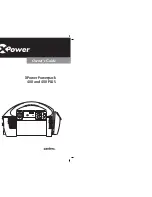
IEEE 488.2 compatible Status Structures
Status reporting
The Output Register
0 0 0 ARM
RLY
POL
ON
STBY
ARM ............... the Power Module is Armed (new SET and PROT values are stored and
do not effect the output)
RLY ................ Output Disconnect Relay is closed (0) or open (1).
POL................. Output Polarity (using relays) is Positive (0) or Negative (1).
ON................... Power Module’s output is enabled (1).
STBY .............. Power Module’s output is actually disabled - Standby (1).
The Output Register shows the current state of the Power Module.
The Faults Register
0 0 0 R_FB
TEMP
OVP
OCP
SENS
R_FB............... Retry Foldback caused the Power Module to shutdown (1).
TEMP.............. Power Module Over Temperature (1).
OVP ................ Power Module’s Over Voltage Protection was tripped (1).
OCP................. Power Module’s Over Current Protection was tripped (1).
SENS............... Power Module’s Sense lines have excessive voltage drop (1).
The Faults Register shows the current state of the Power Module.
The Status Register
0 0 0 CAL
CONF
FLT
WRN
1
CAL ................ Power Module is not calibrated (1).
CONF.............. the confidence Test had errors (1).
FLT ................. the Faults Register has some bits set (1).
WRN ............... the Warnings Register has some bits set (1).
The Status Register shows the current state of the Power Module.
Bit 0, usually returns 1 (this is the Power Module’s ready flag - it will be
0 during the execution of lengthy commands mostly inaccessible to the
user).
The Error Code
The Power Module’s Error Code Byte is cleared when read.
The Events Enable Register
PON 0
CMD OUT ERR FLT WRN OPC
The Events Enable Register has the same structure as the Events register. It is used as a
mask for generating the Power Module’s Status Summary Bit. A set bit in the Events
Enable Register enables the corresponding Events Register bit to set the Summary Bit.
The register is set with the CESE <int> Command and read with the CESE? Query.
70
XMP 2600 Programming Manual
rev. 1.1











































